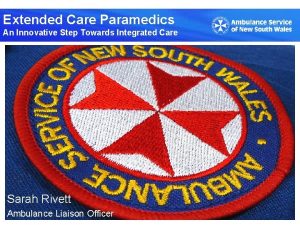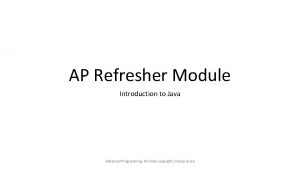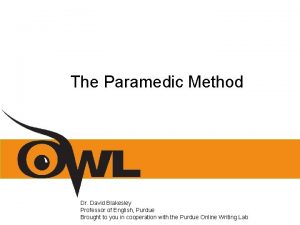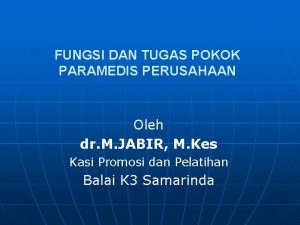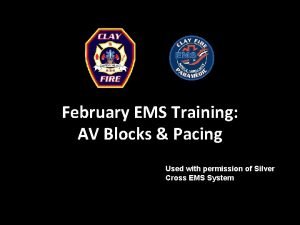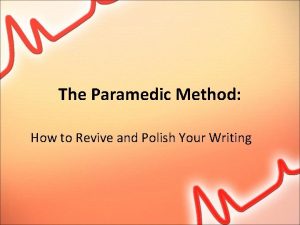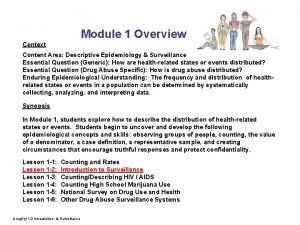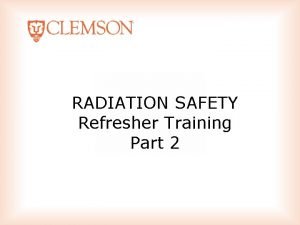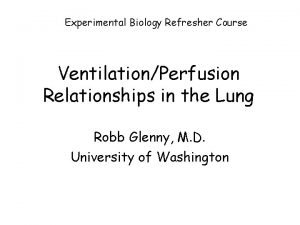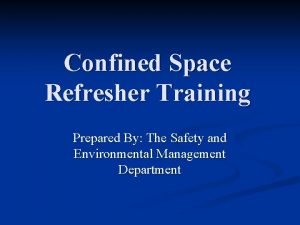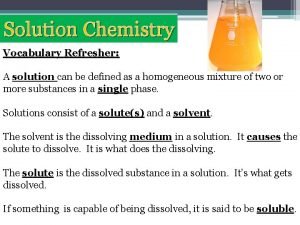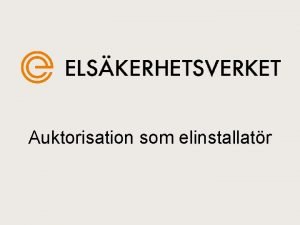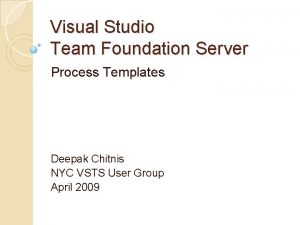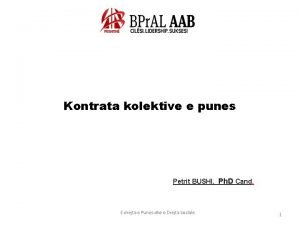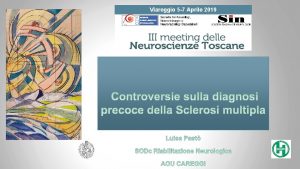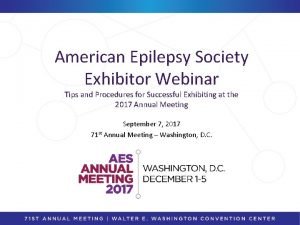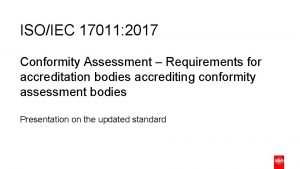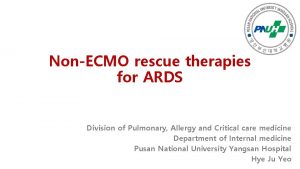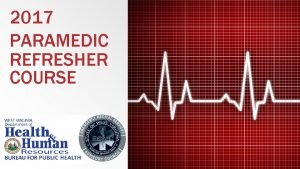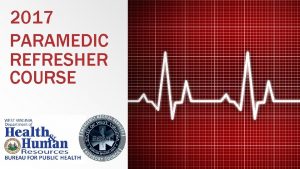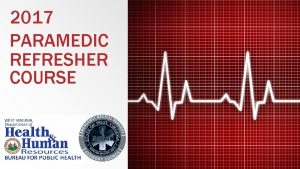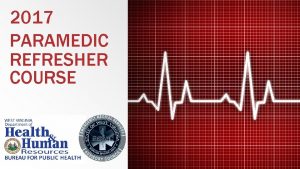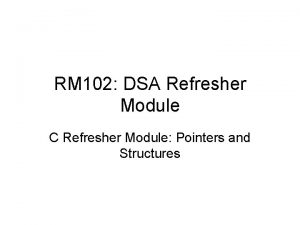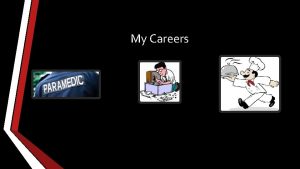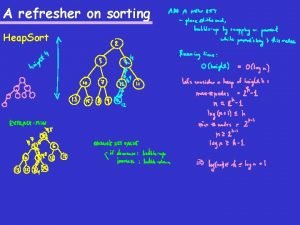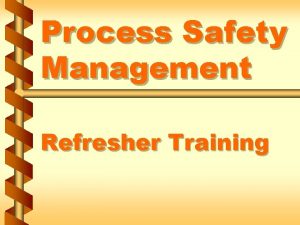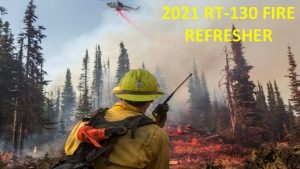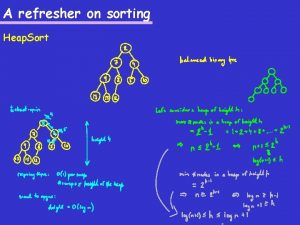2017 PARAMEDIC REFRESHER COURSE Paramedic Refresher Module I



































































































- Slides: 99

2017 PARAMEDIC REFRESHER COURSE

Paramedic Refresher Module # I Respiratory Neurological Management AIRWAY RESPIRATION VENTILATION NEUROLOGICAL

Objectives ▪ Differentiate between adequate and inadequate breathing. ▪ Differentiate between respiratory distress and failure. ▪ Explain when to oxygenate and when to ventilate a patient. ▪ Identify the use of automated transport ventilators when managing patients. ▪ Demonstrate effective BVM ventilation at a proper rate and depth. ▪ Discuss advantages and disadvantages of various advanced airway adjuncts.

Mechanics of Breathing: Inhalation ▪ Contraction of external intercostal muscles ▪ Elevates ribs and sternum ▪ Contraction of diaphragm ▪ Diaphragm moves downward ▪ Air pressure lowers in the lungs ▪ Negative pressure draws air into the lungs

Mechanics of Breathing: Exhalation ▪ External intercostal muscles relax ▪ Diaphragm relaxes ▪ Ribs and sternum return to a resting position ▪ Pressure increases in the lungs ▪ Air is exhaled

Respiratory Physiology

Respiratory Physiology ▪ Primary function of the respiratory system is to provide oxygen for the cells of the body and eliminate carbon dioxide that cells produce. ▪ Exchange of gasses occur at the alveoli. ▪ Oxygen diffuses into the cells from the alveoli and carbon dioxide diffuses into the alveoli from the cells.

Respiratory Physiology

Alveoli ▪ A film of water coats the alveolar walls ▪ As we exhale the alveoli shrink and the water molecules become closer together creating surface tension ▪ Because of the increased surface tension, alveoli may be vulnerable to collapsing if it wasn’t for Pulmonary Surfactant

What is Pulmonary Surfactant? ▪ Surfactant decreases surface tension ▪ Increases pulmonary compliance ▪ Reduces tendency of alveolar collapse

External and Internal Respiration ▪ External respiration ▪ Exchange of O 2 and CO 2 between the environment and the cells ▪ Internal respiration ▪ Intracellular use of O 2 to create ATP ▪ Occurs due to diffusion in relationship to partial pressure gradients

What is Partial Pressure? ▪ Pressure exerted by a single gas within a mixture of gasses ▪ A gasses partial pressure is a measurement of how much gas is present in the blood or alveoli

Partial Pressure of O 2 and CO 2 in the Body ▪ Alveoli ▪ PO 2: 100 mm HG ▪ PCO 2: 40 mm HG ▪ Alveolar Capillaries ▪ PO 2: 40 mm HG (Low because this blood has just returned from systemic circulation) ▪ PCO 2: 45 mm HG (High because the blood returning from systemic circulation is carrying CO 2) ▪ Because of the differences in partial pressure, oxygen can diffuse into the cells and carbon dioxide can diffuse into the blood

How are Oxygen and Carbon Dioxide Carried in the Blood? ▪ Oxygen is carried in the blood ▪ 98. 5% of all oxygen is bound to hemoglobin ▪ 1. 5% is dissolved in plasma ▪ Carbon dioxide transported from the body by cells ▪ 60% bicarbonate ▪ 30% carbaminohemoglobin (formed when CO 2 combines with hemoglobin) ▪ 10% dissolved in plasma ▪ Because almost all oxygen is bound to hemoglobin, the relationship between partial pressure of oxygen and hemoglobin saturation is important.

Oxygen Dissociation Curve

Respiration Control ▪ Rhythmicity center of the Medulla ▪ Controls automatic breathing ▪ Consists of interacting neurons that fire under inspiration (I neurons) or expiration (E neurons) ▪ Apneustic center ▪ Located in the Pons ▪ Stimulate I neurons ▪ Pnemotaxic center ▪ Located in the Pons as well ▪ Inhibits apneustic center and inspiration

Factors in Increasing Respiration ▪ Chemoreceptors located in the aorta and carotid arteries and also in the medulla ▪ Chemoreceptors are stimulated more by increased CO 2 levels than by decreased O 2 levels.

Adequate Breathing ▪ Respiratory rate is within normal limits ▪ Respiratory rhythm is regular ▪ Breath sounds are present, clear, and equal ▪ Chest expansion is adequate and equal ▪ Depth of respirations are adequate

Tidal Volume (Vt) ▪ The volume of air a person moves in and out of the respiratory system in each breath

Minute Ventilation (MV) ▪ The volume of air moved in and out of the respiratory system in (1) minute ▪ Tidal volume x respiratory rate Example: Vt of 500 m. L x Respiratory rate of 12 breaths per minute = 6000 m. L/minute

Alveolar Ventilation (Va) ▪ Alveolar ventilation ▪ The volume of air reaching the alveoli that participates in gas exchange ▪ (Tidal volume – Dead-air Space) x Respiratory Rate Example: (500 m. L – 150 m. L) x 12 breaths per minute = 4200 m. L/minute

Inadequate Breathing ▪ Causes ▪ An inadequate tidal volume ▪ An inadequate rate ▪ A combination of inadequate tidal volume and rate Inadequate breathing requires immediate management with positive pressure ventilations.

Increasing the rate of ventilation on a patient with inadequate tidal volume may maintain near normal MV, however Va where gas exchange occurs will be inadequate to maintain perfusion.

Ventilation and Circulation ▪ Cardiac Output ▪ Stroke Volume x Heart Rate = Cardiac Output ▪ Stroke Volume ▪ Amount of blood ejected from the left ventricle with each contraction

Ventilation and Circulation ▪ During normal respiration ▪ The negative pressure caused by inhalation allows venous blood return to the right side of the heart ▪ During positive pressure ventilation ▪ Air is forced into the chest causing increased intrathoracic pressure ▪ Increased intrathoracic pressure impedes venous blood return to the right side of the heart.

Respiratory Distress vs Respiratory Failure ▪ Respiratory conditions are dynamic ▪ Minor respiratory distress to respiratory arrest ▪ Acute, chronic, or chronic with acute exacerbation ▪ Signs and symptoms are dynamic and may change over time depending on the state of the disease process ▪ Many patients with respiratory disease only require comfort measures ▪ It is important to understand when intervention is required in order to improve the patient’s condition

Respiratory Distress vs Respiratory Failure ▪ Respiratory Distress ▪ A symptom that the patient may be experiencing. ▪ Additional symptoms of respiratory distress ▪ ▪ ▪ Agitation Anxiety Restlessness Accessory muscle use Nasal flaring Tachycardia

Respiratory Distress vs Respiratory Failure ▪ Respiratory failure ▪ Inadequate gas exchange at the alveolar level ▪ Two types of respiratory failure ▪ Hypoxic (Type 1) ▪ Hypercapnic (Type 2)

Respiratory Distress vs Respiratory Failure ▪ Hypoxic (Type 1) ▪ Blood gas or pulse oximeter PAO 2 or Sp. AO 2 are decreased ▪ The cells are not getting enough oxygen

Respiratory Distress vs Respiratory Failure ▪ Hypercapnic (Type 2) ▪ Patient is unable to eliminate CO 2 ▪ Elevated ETCO 2

Respiratory Distress vs Respiratory Failure ▪ Must recognize the transition of a respiratory disease from distress to failure ▪ ▪ ▪ ▪ ▪ Deterioration in mental status Confusion Loss of gag reflex Accessory muscle use Head bobbing Grunting Nasal flaring Decrease in Sp. O 2 Cyanosis Hypercarbia

Oxygenation and Ventilation ▪ Oxygenation ▪ Addition of oxygen to the body ▪ Ventilation ▪ Exchanges air between the lungs and the atmosphere so that oxygen can be absorbed and carbon dioxide can be removed Example: If you hyperventilate with room air, you will lower your arterial carbon dioxide content (Pa. CO 2) significantly, but your oxygen levels won’t change much at all. On the other hand, if you breathe a high concentration of oxygen, but don’t increase or decrease your respiratory rate, your arterial oxygen content (Pa. O 2) will greatly increase, but your Pa. CO 2 won’t change.

Oxygenation and Ventilation ▪ Hypoventilation is a common cause of hypoxia. ▪ When breathing room air, CO 2 takes up space in the alveoli, leaving less room for O 2

Oxygenation and Ventilation ▪ Alveolar Gas Equation ▪ PAO 2 = Fi. O 2 (PB – PH 2 O) – PACO 2/ R ▪ ▪ ▪ Where: PAO 2 = partial pressure of oxygen in the alveoli Fi. O 2 = concentration of inspired oxygen PB = the barometric pressure where the patient is breathing PH 2 O = the partial pressure of water in the air (usually 47 mm. Hg) PACO 2 = alveolar carbon dioxide tension R = respiratory quotient, a constant usually assumed to be 0. 8

Oxygenation and Ventilation ▪ Alveolar gas equation example Patient with a narcotic overdose, at sea level and breathing room air, has an alveolar PACO 2 of 80 mm. Hg, or twice normal. That carbon dioxide takes up space and leaves less room for oxygen. ▪ Using the Alveolar Gas Equation, that PAO 2 calculation is: PAO 2 = 0. 21 (760 – 47) – 80/0. 8 = 49 mm. Hg ▪ Normal PAO 2 is about 100 mm. Hg, so this is quite hypoxic, especially since the alveolar PAO 2 is always a little higher than the arterial Pa. O 2. If it weren’t, oxygen would not flow out of the alveoli into the blood — it would stay in the alveoli.

Oxygenation and Ventilation ▪ Treating the same patient with 50% oxygen improves PAO 2 = 0. 5 (760 – 47) – 80/0. 8 = 256 mm HG ▪ With 50% oxygen PAO 2 went from 49 mm HG to 256 mm HG ▪ Placing this patient on oxygen increased PAO 2 without changing ventilation ▪ In this scenario with a reversible cause treatment, reversal can be performed with out further need for management. ▪ If the cause is not easily reversible the oxygen does protect the brain and heart while manually ventilating or intubating.

Oxygenation and Ventilation ▪ I. AHA Guidelines now recommend that patients with suspected acute coronary syndrome (ACS) or stroke not receive oxygen unless ▪ Sp. O 2 less than 94% (on room air) ▪ If pulse oximeter is unreliable or not available, oxygen should be administered ▪ Presenting with dyspnea ▪ Has signs and symptoms of shock or heart failure

Oxygenation and Ventilation ▪ Oxygenation of chest pain and stroke patients ▪ 2 L/min via nasal cannula for patients who ▪ ▪ Complain of dyspnea Experience signs and symptoms of shock Experience heart failure Have an Sp. O₂ of less than 94% (on room air) ▪ Titrate oxygen to maintain an Sp. O₂ of at least 94%

Oxygenation and Ventilation ▪ Tissue damage may increase ▪ When high concentrations of oxygen are given to ACS and stroke patient ▪ Oxygen releases “free radicals; ” therefore, it is no longer recommended ▪ Free radicals ▪ Byproducts of metabolism ▪ Toxic to neighboring cells ▪ Destroys their membranes ▪ Causes increased local tissue damage ▪ Reintroducing high concentrations of oxygen to cells that have been functioning anaerobically increases the production of free radicals causing cell membrane damage and tissue death ▪ Delivering high concentrations of oxygen to ACS and Stroke patients may be more harmful than keeping the patient on room air

Importance of Proper Ventilation ▪ Excessive ventilation ▪ Decreases cardiac output ▪ Decreases vital organ perfusion Artificial ventilation rates greater than 12 times per minute results in poor patient outcomes.

Mastering the BVM ▪ Indications ▪ Respiratory failure (failure to ventilate and oxygenate)

Mastering the BVM ▪ Contraindications ▪ Complete upper airway obstruction

Mastering the BVM ▪ Positioning ▪ Place towels under the patient’s head to position the ear level with the sternal notch ▪ Extend the patient’s head slightly

Mastering the BVM ▪ Technique ▪ Open the airway ▪ Head-tilt chin lift ▪ Jaw thrust ▪ Place a simple airway adjunct ▪ Position the mask ▪ Use correctly sized mask for a good seal ▪ Hold the mask in place using E-C technique ▪ Two-rescuer allows for a better seal ▪ Ventilate the patient ▪ Give 1 breath over 1 second watching for chest rise and fall ▪ Do not over squeeze the BMV, only chest rise is needed. ▪ Ventilate at 10 -12 breaths per minute providing adequate tidal volume ▪ Monitor for air leak ▪ Be cognizant of gastric inflation

Pearls of the BVM ▪ Lift the mandible up to the mask rather than pushing the mask down ▪ An adequate seal can be made easier with a mask that is too larger compared to one that is too small ▪ Leave dentures in place when possible ▪ If facial hair is making obtaining a seal difficult use water soluble lubricant over the facial hair to improve mask to face contact ▪ The best way to prevent aspiration is good technique

Capnography: Ventilation Vital Sign ▪ Capnography and ETCO 2 ▪ ▪ ▪ Provides breath-to-breath ventilation data Provides real-time information about respiratory effort Help determine the cause of respiratory distress Provides real-time feedback on how well treatment is working Provides confirmation of ET tube placement Can help determine shock

Capnography ▪ ETCO 2 represents the amount of CO 2 in exhaled air ▪ Normal ETCO 2 – 35 -45 mm HG ▪ Capnography measures and displays respiratory rate ▪ Changes in respiratory rate are displayed immediately in the waveform and on ETCO 2

Capnography ▪ Relationship between CO 2 and respiratory rate ▪ Increased RR = decreased CO 2 = Hyperventilation (ETCO 2 <35 mm HG) ▪ Respiratory alkalosis ▪ Decreased RR = increased CO 2 = Hypoventilation (ETCO 2 >45) ▪ Respiratory acidosis

Capnography ▪ Interpreting ETCO₂ and the capnography waveform ▪ ▪ ▪ ▪ ▪ Normal waveform of one respiratory cycle (Similar to ECG) Height shows amount of CO₂ Length depicts time Waveforms on screen and printout may differ in duration On-screen capnography waveform is condensed to provide adequate information the in 4 -second view Printouts are in real-time Capnograph detects only CO₂ from ventilation No CO₂ present during inspiration Baseline is normally zero

Capnography ▪ Phase I ▪ Respiratory baseline ▪ Phase II ▪ Expiratory upstroke ▪ Phase III ▪ Expiratory plateau ▪ ETCO 2 ▪ Peak level and the numerical reading displayed ▪ Phase IV ▪ Inspiratory downstroke

Capnography

Capnography ▪ ETCO 2 vs Pulse Oximetry ▪ ETCO 2 assess ventilation whereas pulse oximetry assesses oxygenation ▪ ETCO 2 will show immediate change in ventilation status whereas pulse oximetry will be delayed in showing decreased oxygenation ▪ ETCO 2 does not provide false or inaccurate readings from factors such as methemoglobin, poor perfusion, movement, or even nail polish

Capnography ▪ Nonintubated applications ▪ ▪ Bronchospasm Hypoventilation Shock and circulatory compromise Hyperventilation syndrome

Capnography ▪ Bronchospasm ▪ Shark fin with/without prolonged expiration ▪ Asthma, COPD, Allergic reaction ▪ Management ▪ Bronchodilators

Capnography ▪ Exertional exhalations ▪ Elevated CO 2 levels should stimulate faster respiration ▪ No effort is needed to exhale CO 2 ▪ In COPD, asthma, and pneumonia patients must exert themselves to exhale and release trapped CO 2 ▪ Patients with these conditions may be inhaling enough oxygen to maintain a normal Sp. AO 2, however they are struggling to remove CO 2 ▪ These patients are not effectively eliminating CO 2 and may be progressing to respiratory failure from hypercarbia and fatigue, not hypoxia

Capnography ▪ Hypoventilation ▪ Prolonged waveform ▪ Baseline CO 2 = 0 ▪ ETCO 2 >45 mm HG ▪ Management ▪ Assist ventilations or intubate

Capnography ▪ Shock and circulatory compromise ▪ Capnography has a ventilatory and circulatory component ▪ Low ETCO 2 and other associated signs of shock indicates poor systemic perfusion

Capnography ▪ Hyperventilation Syndrome ▪ Shortened waveform ▪ Baseline CO 2 = 0 ▪ ETCO 2 <35 mm HG ▪ Management ▪ If conscious utilize the numbers to have patient slow respirations

Capnography ▪ Hyperventilation exceptions ▪ ETCO 2 is high with tachypnea ▪ Severe metabolic acidosis ▪ ▪ ▪ DKA Sepsis Salicylate poisoning Acute renal failure Methanol ingestion Tricyclic overdose

Capnography If respirations are increased and ETCO 2 is high consider the previous diagnosis and treat accordingly. ELEVATED RESPIRATIONS AND HIGH ETCO 2 IS NOT NORMAL!

Capnography ▪ Intubated applications ▪ ▪ ▪ Verification of ETT placement ETT surveillance during patient movement and transport CPR efficiency ROSC Survival predictor

Capnography ▪ ETT Confirmation ▪ Esophageal Intubation ▪ Absence of waveform ▪ Absence of ETCO 2 ▪ Management ▪ Re-intubate

Capnography ▪ ETT Confirmation ▪ Right Main Intubation ▪ Waveform represents differential ventilation of two lungs ▪ Transition phase of gas escaping from the left lung up the tube ▪ Management ▪ Pull ETT back

Capnography ▪ ETT surveillance ▪ Dislodged ETT ▪ Loss of waveform ▪ Loss of ETCO 2 reading ▪ Management ▪ Replace ETT

Capnography ▪ CPR efficiency ▪ Normal waveform ▪ Baseline CO 2 = 0 ▪ ETCO 2 = 10 -15 mm HG (maybe higher with good CPR) ▪ Management ▪ Change rescuers if ETCO 2 drops below 10 mm HG

Capnography

Capnography ▪ ROSC ▪ CPR ▪ Rapid jump in ETCO 2 from baseline of CPR ▪ Management ▪ Check for a pulse

Capnography ▪ Survival predictor ▪ Initial ETCO 2 of > 10 mm HG = higher chance of ROSC ▪ A decrease of > 25% in ETCO 2 during resuscitation = significant likelihood of mortality ▪ ETCO 2 is a great tool to determine when to cease efforts and when efforts should continue

Capnography

Advanced Airway Adjuncts ▪ Oropharyngeal Airway (OPA) ▪ Indications ▪ Respiratory distress/failure ▪ Unconscious/unresponsive ▪ Contraindications ▪ Gag reflex ▪ Presence of oral trauma (broken teeth, recent oral surgery, etc. )

Advanced Airway Adjuncts ▪ Nasopharyngeal (NPA) ▪ Indications ▪ Respiratory distress/failure ▪ Contraindications ▪ Presence of head, facial trauma ▪ Presence of skull fracture

Advanced Airway Adjuncts ▪ Supraglottic ▪ Examples ▪ ▪ Laryngeal mask airway (e. g. , LMA™) Esophageal-tracheal tube (e. g. , Combitube™) Laryngeal tube (e. g. , King LT ™) I-Gel ii.

Advanced Airway Adjuncts ▪ Advantages ▪ ▪ Does not require visualization of the glottis (blind insertion) Initial training and maintenance of skills are easier Chest compressions do not need to be interrupted to insert Minimal equipment required for insertion ▪ Disadvantages ▪ Contraindicated in patients with a gag reflex ▪ Some devices contraindicated in patients at risk for regurgitation which can lead to aspiration (e. g. , LMA™) ▪ Unrecognized improper placement can occur

Advanced Airway Adjuncts ▪ Endotracheal Tube (ETT) ▪ Advantages ▪ Keeps the airway patent ▪ May protect the airway from aspiration ▪ Allows suctioning of deep airway secretions ▪ Potential route for drug administration ▪ Disadvantages ▪ Difficult initial training ▪ Insufficient skill maintenance without frequent practice ▪ Frequently causes trauma to the oropharynx ▪ Hypoxemia possible with prolonged intubation attempts ▪ Adverse outcomes common when providers fail to recognize tube displacement or misplacement ▪ High incidence of complications when performed by inexperienced providers with inadequate monitoring of tube placement

Airway Management in Cardiac Arrest ▪ ALS Airway management ▪ BVM ▪. Avoid hyperventilation as it decreases preload ▪ Best technique is the 2 -Rescuer technique with one rescuer holding mask seal and the other squeezing the bag with both rescuers watching for chest rise ▪ 2 breaths for every 30 compressions without an advanced airway ▪ One breath every 6 -8 seconds after placement of advanced airway ▪ May need to adjust ventilator rate based on capnography ▪ Endotracheal Tube (ETT) ▪ Compressions should not be interrupted in the placement of an ETT ▪ Supraglottic airways ▪ Considered an advanced airway ▪ Alternative to ETT placement ▪ Acceptable during CPR

Airway Management in Cardiac Arrest ▪ Capnography should be attached to these airways ▪ Continuous waveform capnography ▪ Typically 35 -45 mm Hg in a normally perfusing patient ▪ Greater than 45 mm Hg ▪ Ensure adequate ventilatory rate and volume 1 ▪ 15 -35 mm Hg ▪ Common in cardiac arrest patients with CPR in progress ▪ Less than 10 -15 mm Hg ▪ Focus efforts on improving chest compressions ▪ Make sure the victim is not receiving excessive ventilations

Airway Management in Cardiac Arrest ▪ A sudden increase in ETCO₂ could indicate a return of spontaneous circulation (ROSC) ▪ Use caution with interpretation of ETCO₂ values within 1 -2 minutes after administration of epinephrine due to decreased pulmonary blood flow

CPAP ▪ Continuous Positive Airway Pressure (CPAP) ▪ CPAP is used to provide better oxygenation to patients who are hypoxic ▪ Not designed to ventilate patients ▪ Reduces the effort for the patient to breathe, improves oxygenation and reduces hypercarbia ▪ Can prevent the exacerbation of respiratory distress or respiratory failure ▪ Applies positive airway pressures above atmospheric pressure during inhalation and provides positive end expiratory pressure (PEEP) during exhalation

CPAP ▪ Indications ▪ Patient needing ventilatory support who is in moderate to severe respiratory distress or early respiratory failure ▪ Patient must be awake, able to obey commands, and have intact airway reflexes ▪ Contraindications ▪ Inability to maintain an open airway ▪ Severe hypotension (systolic BP < 90) ▪ A respiratory rate of less than 8 breaths/min ▪ The EMS provider needs to deliver assisted artificial ventilations to patients who exhibit deterioration in mental status because of hypoxia and hypercarbia

Automated Transport Ventilators ▪ Automated Transport Ventilators (ATV) ▪ Intubated patients requiring artificial ventilation for a period of time may benefit from use of ATV, instead of BVM ▪ Advantages ▪ ▪ Can be used for breathing and non-breathing patients Patients in respiratory failure Frees the rescuer for other tasks Adjustable settings provide specific tidal volume, respiratory rate, and minute ventilation ▪ Disadvantages ▪ Need for an oxygen source, and sometimes electric power ▪ Inability to detect increasing airway resistance ▪ Some ATVs should not be used in children younger than 5 years old

Neurological Emergencies ▪ Define AMS ▪ State common causes of AMS ▪ Define status epilepticus ▪ Explain complications associated with seizures

Neurological Emergencies ▪ Altered mental status definition and causes ▪ Definition: change in a person’s level of awareness ▪ Causes (AEIOU-TIPPSS— acronym for assessment of AMS patient) ▪ Alcohol ▪ Epilepsy (seizures) ▪ Insulin (diabetic condition) ▪ Oxygen (lack of) ▪ Uremia (kidney failure) ▪ Trauma ▪ Infection ▪ Psychiatric ▪ Poisoning (including drug overdose) ▪ Shock ▪ Stroke

Neurological Emergencies ▪ Types of seizures ▪ Generalized ▪ Tonic-clonic ▪ Absence ▪ Partial ▪ Simple ▪ Complex ▪ Status epilepticus

Generalized Seizures ▪ Tonic seizure ▪ Muscles stiffen and the patient loses consciousness ▪ Muscles contract and the back arches ▪ Chest muscles tighten and breathing becomes difficult ▪ Cyanosis to lips and face possible ▪ Clonic seizure ▪ Muscles spasm and jerk ▪ Muscles will flex and relax rapidly

Generalized Seizure ▪ Tonic-clonic (grand mal) seizures ▪ Tonic and clonic seizure occur together ▪ Rare to experience one without the other ▪ Absent (petit mal) seizure ▪ ▪ ▪ Uncommon Occurs suddenly and without warning Appear to stare without moving Usually last less than 15 seconds Normally no postictal period

Partial Seizure ▪ Simple partial seizure ▪ Localized to one area of the brain ▪ No lost of consciousness

Partial Seizure ▪ Simple partial seizure is broken into four catergories ▪ Motor ▪ A simple partial seizure with motor symptoms will affect muscle activity, causing jerking movements of the foot, face, arm, or another part of the body. ▪ Sensory ▪ A simple partial seizure with sensory symptoms affect the senses: hearing problems, possible hallucinations, and other distortions. ▪ Autonomic ▪ A simple partial seizure with autonomic symptoms affects the part of the brain responsible for involuntary functions: it may cause changes in blood pressure, heart rhythm, bowel function, etc. ▪ Psychic ▪ A simple partial seizure with psychic symptoms affects parts of the brain that trigger emotions or previous experiences: it may cause feelings of fear, anxiety, déjà vu

Partial Seizure ▪ Complex partial seizure ▪ ▪ ▪ Affect any lobe of the brain Cause alteration of awareness due to spreading seizure activity An aura often described as a warning may present Patients may stare blankly into space Non-purposeful/repetitive movements

Status Epilepticus - Definition ▪ A continuous seizure lasting more than 30 minutes ▪ Two or more seizures without regaining consciousness between any of them ▪ Prolonged seizures last between 5 and 30 minutes ▪ Should be treated as status epilepticus

Status Epilepticus - Epidemiology ▪ Mortality rate can be around 20% ▪ Especially if treatment is not initiated quickly ▪ Highest mortality occurs from anoxic and cerebrovascular causes ▪ Seizure duration is the greatest predictor of mortality ▪ Status epilepticus lasting >1 hour has significantly higher mortality ▪ Most common in ages >60 years old and <12 months old ▪ High prevalence in patients with chronic epilepsy

Status Epilepticus – Time is Brain ▪ Status is an emergency and needs to be treated promptly

Physiologic Changes in Status Epilepticus ▪ Phase 1: Compensation ▪ ▪ First 30 minutes Cerebral metabolism is increased due to the seizure activity The body is able to meet the increased metabolic demands Cerebral tissue is protected from hypoxia and metabolic damage

Physiologic Changes in Status Epilepticus Increased brain metabolism Elevated systemic and pulmonary artery pressure Increased cardiac output Hypertension Tachycardia Cardiac arrhythmias Hypercalcemia Lactic acidosis Massive catecholamine release Hyperthermia Incontinence Vomiting

Physiologic Changes in Status Epilepticus ▪ Phase 2: Decompensation ▪ ▪ Occurs after 60 minutes Increased metabolic demands cannot be met Hypoxia Cardiorespiratory functions may progressively fail to maintain homeostasis

Physiologic Changes in Status Epilepticus Failure of cerebral autoregulation Respiratory and cardiac impairments Hypoglycemia Systemic hypoxia Hypotension Failing cardiac output Hepatic and Renal dysfunction Metabolic and Respiratory acidosis Hypo/hyperkalemia Coagulopathies Falling lactate levels Rhabdomyolysis Multi-organ failure Hyperthermia Luekocytosis Increased ICP

Status Epilepticus ▪ Complications ▪ ▪ Aspiration Bone and spine fractures Brain damage from lack of oxygen and/or depletion of glucose Dehydration

Neurological Emergencies ▪ Causes ▪ ▪ ▪ Medication non-compliance Rapid increase in body temperature (febrile) Infection Hypoxia TBI Alcohol or drug withdrawal Stroke Hypoglycemia Eclampsia Seizure disorder Electrolyte disturbances Poisoning

Neurological Emergencies ▪ Assessment findings ▪ ▪ ▪ Spasms/muscle contractions/shaking or tremors Sweating Cyanosis during seizure activity Increased secretions Incontinence Postictal state

Neurological Emergencies ▪ Management ▪ Protect from further injury; position on side to protect airway ▪ Ensure open airway, adequate ventilations, and oxygenation ▪ Consider using an NPA ▪ Provide emotional support; reduce stimulants that may trigger more seizures ▪ IV or IO ▪ Consider administering a benzodiazepine
 Extended care paramedics
Extended care paramedics Ipv refresher course
Ipv refresher course Saeta refresher course 2021
Saeta refresher course 2021 Java refresher course
Java refresher course The paramedic method
The paramedic method Tugas staf paramedis
Tugas staf paramedis Silver cross paramedic program
Silver cross paramedic program Paramedic method
Paramedic method Lone star college nursing
Lone star college nursing C device module module 1
C device module module 1 Leader safety course module 2 answers
Leader safety course module 2 answers Course module sample
Course module sample One and half brick wall
One and half brick wall Course title and course number
Course title and course number Chaine parallèle muscle
Chaine parallèle muscle Red helmet training
Red helmet training Gdpr refresher training
Gdpr refresher training Rcra hazardous waste refresher
Rcra hazardous waste refresher Refresher training example
Refresher training example Confined space refresher training
Confined space refresher training Alveolar gas equation
Alveolar gas equation Biology refresher
Biology refresher Object oriented programming exercises java
Object oriented programming exercises java Sql refresher
Sql refresher Ifr refresher
Ifr refresher Annual security refresher
Annual security refresher Confined space refresher
Confined space refresher Chemistry molarity
Chemistry molarity Refresher training example
Refresher training example Security annual refresher training
Security annual refresher training Auktorisation lågspänning
Auktorisation lågspänning Saasta astro quiz 2019 questions and answers
Saasta astro quiz 2019 questions and answers Occ bulletin 2017-7
Occ bulletin 2017-7 Tfs process template editor
Tfs process template editor Ceinture boa concours lépine 2017
Ceinture boa concours lépine 2017 Voorbeeld loonstrook
Voorbeeld loonstrook Kangourou 2017
Kangourou 2017 Inter ikea systems b.v. 2017
Inter ikea systems b.v. 2017 Unsw semester dates 2019
Unsw semester dates 2019 Tattoo 2017
Tattoo 2017 Kontrata kolektive e punes 2021
Kontrata kolektive e punes 2021 Odontojenik tümör sınıflaması
Odontojenik tümör sınıflaması 2017 pearson education inc
2017 pearson education inc Rooster examens 2017
Rooster examens 2017 Jadual waktu kssm
Jadual waktu kssm Oktoberfest 2017 dresses
Oktoberfest 2017 dresses Pearson education 2017
Pearson education 2017 A chip of a glass ruby
A chip of a glass ruby Pearson education limited 2017
Pearson education limited 2017 Matura iz hrvatskog 2018
Matura iz hrvatskog 2018 Cfa bpp
Cfa bpp Pearson education ltd 2017
Pearson education ltd 2017 Lopoca gaming
Lopoca gaming The parish as a communion of communities (2017)
The parish as a communion of communities (2017) 2017 pearson education inc
2017 pearson education inc The education of adela 2017
The education of adela 2017 Deped order no. 13, s. 2017
Deped order no. 13, s. 2017 Psle results 2017
Psle results 2017 Kerala 2017
Kerala 2017 Pgs 15 opslagvoorziening
Pgs 15 opslagvoorziening Que onda con el pase reglamentado 2020
Que onda con el pase reglamentado 2020 Microsoft summit sydney 2017
Microsoft summit sydney 2017 Atlas diabetes 2018
Atlas diabetes 2018 Slidetodoc.com
Slidetodoc.com Enp
Enp Nou 2017:12
Nou 2017:12 American thyroid association guidelines pregnancy 2017
American thyroid association guidelines pregnancy 2017 Maternal and infant health disparities
Maternal and infant health disparities Rirn 2045
Rirn 2045 Visual studio 2017 download
Visual studio 2017 download Erica van schijndel
Erica van schijndel Marketo certified specialist
Marketo certified specialist Tarkista veronumero
Tarkista veronumero 2017 sats mark scheme
2017 sats mark scheme Mcdonald criteria 2017
Mcdonald criteria 2017 Nrg virtual meeting
Nrg virtual meeting Kotler et al 2017
Kotler et al 2017 Voluntary carbon market
Voluntary carbon market Nec article 406
Nec article 406 Mleko 2017 vimeo
Mleko 2017 vimeo American epilepsy society annual meeting 2017
American epilepsy society annual meeting 2017 Elly dia unipr
Elly dia unipr Cit healthcare conference 2017
Cit healthcare conference 2017 Mon tue wed thur fri sat sun
Mon tue wed thur fri sat sun Efy 2017
Efy 2017 Xna game studio visual studio 2017
Xna game studio visual studio 2017 Iso 17011:2017
Iso 17011:2017 Tanya boieva
Tanya boieva Förderung led beleuchtung 2017
Förderung led beleuchtung 2017 Scia engineer 2017
Scia engineer 2017 Webdesign software 2017
Webdesign software 2017 Preference to make in india order 2017
Preference to make in india order 2017 Cyber security ppt 2017
Cyber security ppt 2017 2017 dvhimss annual fall conference
2017 dvhimss annual fall conference Ausbildungsvertrag ihk koblenz
Ausbildungsvertrag ihk koblenz Pltw launch modules
Pltw launch modules Cdes psychology conference
Cdes psychology conference Pcmh huddle worksheet
Pcmh huddle worksheet Ards
Ards Siklus pengelolaan aset pada pp 27 tahun 2017
Siklus pengelolaan aset pada pp 27 tahun 2017
